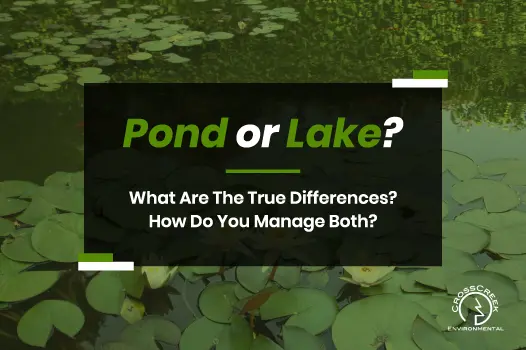POND OR LAKE? WHAT ARE THE TRUE DIFFERENCES? HOW DO YOU MANAGE BOTH?
16 October 2022

One of the most basic questions that any pond and lake management companies in Florida may have to answer for the public concerns the difference between those two waterbodies. This article has been written to give laypersons succinct definitions for each, especially when most people think lakes are for community leisure and ponds are often isolated to one property.
The Scientific Classification of Lakes and PondsThe scientific classification for a waterbody relies upon depth; the deeper one goes, the more complex an environment it offers aquatic flora and fauna.
Ponds tend to be shallow. All of their water is within the "photic zone," a range where sunlight can penetrate down to the bed. The ecosystem of ponder water is more consistent than a lake and can sustain rooted plants, weeds, phytoplankton and algae.
Lakes tend to be deep enough to include an "aphotic zone." Following the photic zone, an aphotic zone is deep enough that sunlight does not penetrate-you will find no plants, phytoplankton or algae at these depths. Lake ecosystems are considerably different from ponds, if only because aphotic zones only contain carnivores.
Other distinctions between lakes and ponds would be wave action and temperature. Pond waves tend to be smaller than a lake's and pond water has a consistent temperature while lake water temperatures fluctuate due to limited solar penetration.
A Quick Checklist
- Does sunlight saturate the whole waterbody?
- Are the waves below a foot in height?
- Is the water temperature uniform?
If you answered "yes" to each question, you have a pond. If you answered "no," you have a lake.
Freshwater vs SalineMost lakes are freshwater, "saline" lakes exist. While most freshwater lakes have a minute level of dissolved salt in their water, saline lakes can have anywhere from 3 to 300 g/L of dissolved salt.
Saline lakes are common in dry areas where water only leaves by evaporation or seeping into the terrain. These processes allow the salts and other chemicals to grow more concentrated over time. While freshwater rivers and lakes empty out into the ocean, saline lakes start at the end of a river; thus the terms "endorheic," "terminal" and "inland sea." These saline lakes tend to arise from the lowest point of a landscape, often within basins. Due to their rarity, most people are familiar with saline lakes by name.
While the Dead Sea's name arose due to perceived inhospitable to life, it contains several varieties of bacteria and algae. Conversely, the Great Salt Lake is home to many creatures, including brine shrimp. Saline lake shores are often treasured breeding grounds and habitats for waterfowl and shorebirds.
While the average person might assume that lakes and ponds are only distinguished by their size, the true distinction comes down their depth. Ponds are single-zone bodies of water with a great deal of uniformity to their composition and inhabitants, while lakes are deep enough to partly avoid sunlight and feature different ecosystems within themselves.



